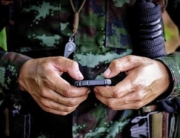Hold leaders accountable and reduce retaliation, researchers advise, rather than take a one-size-fits-all approach to prevention
by Claudia Bustamante
Failing to address the multiple root causes and the role played by military culture will continue to hamper efforts to curtail sexual assault in the military, according to new research from the University of Southern California and Fort Hood, Texas.
The military’s one-size-fits-all approach to sexual assault prevention and training also overlooks sensitive and uncomfortable issues, including the prevalence of assault among male service members and biases about sexual behavior, according to the article, which appears in the May issue of Current Psychiatry Reports.
Though sexual assault is a larger societal issue, several factors about military culture impact its prevalence and the underreporting of incidents, including a fear of retaliation. In 2014, the Department of Defense found that 62 percent of women who reported sexual assault experienced retaliation, either socially or professionally.
Sara Kintzle, co-author and research assistant professor at the USC School of Social Work, said it was important to start looking at sexual assault through a military culture lens. “What is it about the military and what happens that allows these things to take place?” she said. “I think acknowledging this is key if we hope to move forward and change attitudes and behaviors.”
The authors write that the military’s values on formality, discipline, and loyalty, among others, place a premium on “masculine ideals,” such as strength, dominance, and competition that perpetuate a culture of entitlement and acceptance. The importance of team cohesion may also make service members reluctant to disrupt it (i.e., reporting a fellow team member of sexual assault). Similarly, military culture encourages problems be resolved at the lowest level; going up the chain of command to report incidents is frowned upon.
Kintzle said that what separates this paper from others addressing the issue of sexual assault in the military is its inclusion of “elephants in the room”—unpleasant and unpopular topics surrounding assault that are often ignored when crafting policy.
“Sexual assault is something that is really difficult to talk about. There are a lot of aspects of sexual assault that we’re really careful about how we discuss, and that reluctance has created missed opportunities for prevention efforts,” she said.
For example, to avoid appearing to blame the victim, there’s no discussion about how people might have protected themselves. Also, seeing sexual assault as primarily a “women’s issue” ignores the unique nuances associated with male service members who experience it.
The authors suggest a comprehensive approach to tackling sexual assault that considers these multiple causes and military factors. Current training focuses on the definition of assault and how to report it. It has become so inadequate that, in at least one situation, the article states, “this requirement was met by having soldiers stand around a radio and being told by someone at a different location not to touch girls.”
Evidence-based training, improved reporting systems, and increased support for victims are all necessary to stem the prevalence of sexual assault. Above all, the authors recommend holding leaders at all levels accountable for changing their unit’s attitudes on women, assault and harassment, and for ensuring that those who report incidents are not retaliated against.
The co-authors of the article are Carl Castro, Ashley Schuyler and Carrie Lucas from USC, and Christopher Warren, a psychologist at Fort Hood, Texas.







